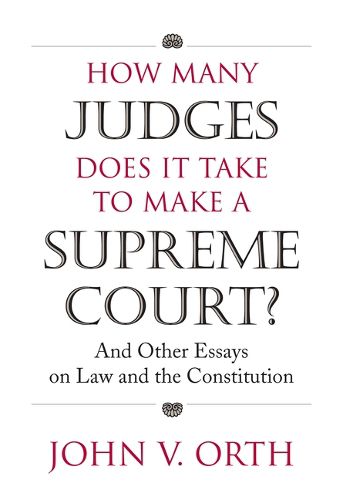Readings Newsletter
Become a Readings Member to make your shopping experience even easier.
Sign in or sign up for free!
You’re not far away from qualifying for FREE standard shipping within Australia
You’ve qualified for FREE standard shipping within Australia
The cart is loading…






Why do appellate courts always have an odd number of judges? And what does the answer tell us about changing concepts of law? How can common law be unconstitutional? Why does the power of judges depend on accurate court reporting? Because legal education today has come to focus so much on teaching students
how to think like lawyers,
some subjects do not fit comfortably in law school curricula. John Orth, a distinguished senior law scholar, here explores some of these neglected but important topics. His insightful volume invites students of the law to look at the origins of accepted legal practices as a means of gaining insight into the judicial role and the evolution of common law. In six carefully reasoned and clearly argued articles, Orth presents the familiar in a fresh light. He considers, in addition to the questions already mentioned, how the centuries-old common law tradition interacts with statutory law-making, why claims that individual rights are grounded in common law are suspect, and how the common law uses what it learns about the past. In considering these questions related to common law and its remarkable longevity, Orth illuminates both its interaction with written constitutions and its longstanding preoccupation with procedure and property. And by questioning the assertion that individualism was the cornerstone of common law, he deftly resolves an objection that liberal scholars sometimes raise concerning common law - its connection to the Lochner era of Supreme Court jurisprudence. How many judges does it take to make a supreme court? As Orth observes, the institutional novelty of odd numbers of judges provided a means to break ties but did nothing to guarantee acceptance of their decisions. By demonstrating that what seems obvious about the law today was not always so, he cogently addresses changing perceptions of law and invites its future practitioners not only to think like lawyers but also to be more fully grounded in the law.
$9.00 standard shipping within Australia
FREE standard shipping within Australia for orders over $100.00
Express & International shipping calculated at checkout
Why do appellate courts always have an odd number of judges? And what does the answer tell us about changing concepts of law? How can common law be unconstitutional? Why does the power of judges depend on accurate court reporting? Because legal education today has come to focus so much on teaching students
how to think like lawyers,
some subjects do not fit comfortably in law school curricula. John Orth, a distinguished senior law scholar, here explores some of these neglected but important topics. His insightful volume invites students of the law to look at the origins of accepted legal practices as a means of gaining insight into the judicial role and the evolution of common law. In six carefully reasoned and clearly argued articles, Orth presents the familiar in a fresh light. He considers, in addition to the questions already mentioned, how the centuries-old common law tradition interacts with statutory law-making, why claims that individual rights are grounded in common law are suspect, and how the common law uses what it learns about the past. In considering these questions related to common law and its remarkable longevity, Orth illuminates both its interaction with written constitutions and its longstanding preoccupation with procedure and property. And by questioning the assertion that individualism was the cornerstone of common law, he deftly resolves an objection that liberal scholars sometimes raise concerning common law - its connection to the Lochner era of Supreme Court jurisprudence. How many judges does it take to make a supreme court? As Orth observes, the institutional novelty of odd numbers of judges provided a means to break ties but did nothing to guarantee acceptance of their decisions. By demonstrating that what seems obvious about the law today was not always so, he cogently addresses changing perceptions of law and invites its future practitioners not only to think like lawyers but also to be more fully grounded in the law.